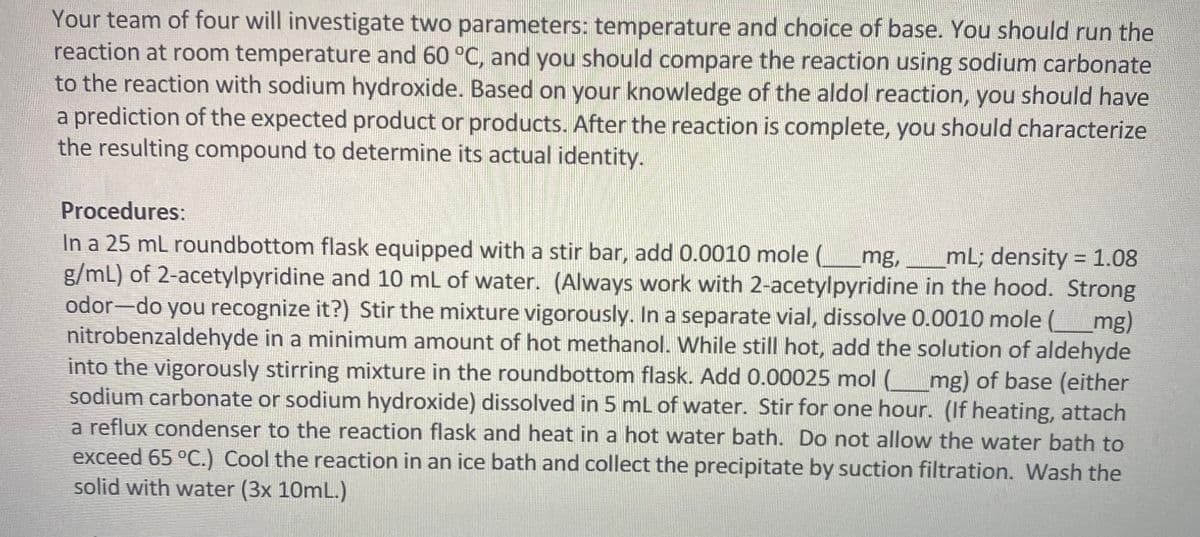Procedures: In a 25 mL roundbottom flask equipped with a stir bar, add 0.0010 mole(____mg, _mL; density = 1.08 g/mL) of 2-acetylpyridine and 10 mL of water. (Always work with 2-acetylpyridine in the hood. Strong odor-do you recognize it?) Stir the mixture vigorously. In a separate vial, dissolve 0.0010 mole (mg) nitrobenzaldehyde in a minimum amount of hot methanol. While still hot, add the solution of aldehyde into the vigorously stirring mixture in the roundbottom flask. Add 0.00025 mol (mg) of base (either sodium carbonate or sodium hydroxide) dissolved in 5 mL of water. Stir for one hour. (If heating, attach a reflux condenser to the reaction flask and heat in a hot water bath. Do not allow the water bath to exceed 65 °C.) Cool the reaction in an ice bath and collect the precipitate by suction filtration. Wash the solid with water (3x 10mL.)
Procedures: In a 25 mL roundbottom flask equipped with a stir bar, add 0.0010 mole(____mg, _mL; density = 1.08 g/mL) of 2-acetylpyridine and 10 mL of water. (Always work with 2-acetylpyridine in the hood. Strong odor-do you recognize it?) Stir the mixture vigorously. In a separate vial, dissolve 0.0010 mole (mg) nitrobenzaldehyde in a minimum amount of hot methanol. While still hot, add the solution of aldehyde into the vigorously stirring mixture in the roundbottom flask. Add 0.00025 mol (mg) of base (either sodium carbonate or sodium hydroxide) dissolved in 5 mL of water. Stir for one hour. (If heating, attach a reflux condenser to the reaction flask and heat in a hot water bath. Do not allow the water bath to exceed 65 °C.) Cool the reaction in an ice bath and collect the precipitate by suction filtration. Wash the solid with water (3x 10mL.)
Organic Chemistry
8th Edition
ISBN:9781305580350
Author:William H. Brown, Brent L. Iverson, Eric Anslyn, Christopher S. Foote
Publisher:William H. Brown, Brent L. Iverson, Eric Anslyn, Christopher S. Foote
Chapter19: Enolate Anions And Enamines
Section: Chapter Questions
Problem 19.67P
Related questions
Question
100%
For the attached procedure, write a general reaction scheme (not mechanism) that shows starting materials, an arrow with the words “basic conditions” over the arrow, and both possible products (addition and condensation).

Transcribed Image Text:Your team of four will investigate two parameters: temperature and choice of base. You should run the
reaction at room temperature and 60 °C, and you should compare the reaction using sodium carbonate
to the reaction with sodium hydroxide. Based on your knowledge of the aldol reaction, you should have
a prediction of the expected product or products. After the reaction is complete, you should characterize
the resulting compound to determine its actual identity.
Procedures:
In a 25 mL roundbottom flask equipped with a stir bar, add 0.0010 mole ( mg, mL; density = 1.08
g/mL) of 2-acetylpyridine and 10 mL of water. (Always work with 2-acetylpyridine in the hood. Strong
odor-do you recognize it?) Stir the mixture vigorously. In a separate vial, dissolve 0.0010 mole (______mg)
nitrobenzaldehyde in a minimum amount of hot methanol. While still hot, add the solution of aldehyde
into the vigorously stirring mixture in the round bottom flask. Add 0.00025 mol (_______mg) of base (either
sodium carbonate or sodium hydroxide) dissolved in 5 mL of water. Stir for one hour. (If heating, attach
a reflux condenser to the reaction flask and heat in a hot water bath. Do not allow the water bath to
exceed 65 °C.) Cool the reaction in an ice bath and collect the precipitate by suction filtration. Wash the
solid with water (3x 10mL.)
Expert Solution
This question has been solved!
Explore an expertly crafted, step-by-step solution for a thorough understanding of key concepts.
This is a popular solution!
Trending now
This is a popular solution!
Step by step
Solved in 3 steps with 2 images

Knowledge Booster
Learn more about
Need a deep-dive on the concept behind this application? Look no further. Learn more about this topic, chemistry and related others by exploring similar questions and additional content below.Recommended textbooks for you

Organic Chemistry
Chemistry
ISBN:
9781305580350
Author:
William H. Brown, Brent L. Iverson, Eric Anslyn, Christopher S. Foote
Publisher:
Cengage Learning


Organic Chemistry: A Guided Inquiry
Chemistry
ISBN:
9780618974122
Author:
Andrei Straumanis
Publisher:
Cengage Learning

Organic Chemistry
Chemistry
ISBN:
9781305580350
Author:
William H. Brown, Brent L. Iverson, Eric Anslyn, Christopher S. Foote
Publisher:
Cengage Learning


Organic Chemistry: A Guided Inquiry
Chemistry
ISBN:
9780618974122
Author:
Andrei Straumanis
Publisher:
Cengage Learning